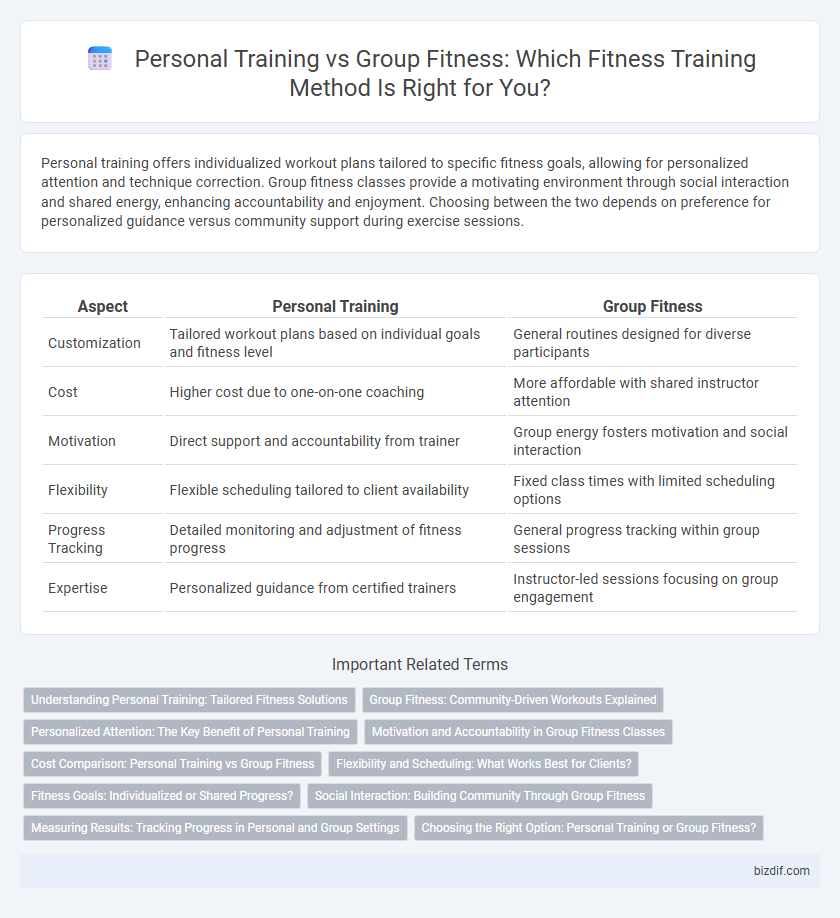Personal training offers individualized workout plans tailored to specific fitness goals, allowing for personalized attention and technique correction. Group fitness classes provide a motivating environment through social interaction and shared energy, enhancing accountability and enjoyment. Choosing between the two depends on preference for personalized guidance versus community support during exercise sessions.
Table of Comparison
| Aspect | Personal Training | Group Fitness |
|---|---|---|
| Customization | Tailored workout plans based on individual goals and fitness level | General routines designed for diverse participants |
| Cost | Higher cost due to one-on-one coaching | More affordable with shared instructor attention |
| Motivation | Direct support and accountability from trainer | Group energy fosters motivation and social interaction |
| Flexibility | Flexible scheduling tailored to client availability | Fixed class times with limited scheduling options |
| Progress Tracking | Detailed monitoring and adjustment of fitness progress | General progress tracking within group sessions |
| Expertise | Personalized guidance from certified trainers | Instructor-led sessions focusing on group engagement |
Understanding Personal Training: Tailored Fitness Solutions
Personal training offers tailored fitness solutions by creating customized workout plans based on individual goals, fitness levels, and health conditions. This personalized approach enhances motivation, ensures proper technique, and adapts progressions to maximize results effectively. Trainers provide one-on-one support, allowing for precise feedback and adjustments that group fitness classes may not accommodate.
Group Fitness: Community-Driven Workouts Explained
Group fitness workouts create a community-driven environment that enhances motivation and accountability through shared goals and collective energy. Social interaction in group settings fosters a supportive atmosphere, boosting adherence and enjoyment of regular exercise. This dynamic setting often leads to improved consistency and greater fitness results compared to solo workouts.
Personalized Attention: The Key Benefit of Personal Training
Personal training offers tailored workout plans that address individual goals, fitness levels, and limitations, ensuring effective and safe progress. Unlike group fitness, where attention is divided among many participants, personal trainers provide continuous, one-on-one guidance and real-time form corrections. This personalized attention maximizes results and reduces the risk of injury, making it the optimal choice for those seeking targeted fitness improvements.
Motivation and Accountability in Group Fitness Classes
Group fitness classes elevate motivation through collective energy and shared goals, fostering a supportive environment that encourages consistent participation. Accountability is enhanced as participants commit to scheduled sessions and motivate each other, reducing the likelihood of missed workouts. This social dynamic often results in sustained exercise adherence compared to solo personal training sessions.
Cost Comparison: Personal Training vs Group Fitness
Personal training typically costs between $50 and $100 per session, offering tailored workouts and individualized attention, while group fitness classes usually range from $10 to $30 per session, providing a more affordable option with social motivation. The higher price of personal training reflects customized programming and one-on-one coaching, whereas group fitness spreads instructor costs over multiple participants, reducing individual expenses. Budget-conscious individuals may prefer group fitness for lower costs, but those seeking personalized guidance often find the investment in personal training worthwhile.
Flexibility and Scheduling: What Works Best for Clients?
Personal training offers customized flexibility in scheduling, allowing clients to select times that best fit their individual routines and adapt workouts to evolving goals. Group fitness classes have fixed schedules and provide social motivation but may not always align with each client's preferred timing or specific fitness needs. Clients seeking personalized attention and adjustable timing benefit most from personal training, while those valuing community engagement and structured class times may prefer group fitness.
Fitness Goals: Individualized or Shared Progress?
Personal training offers tailored workout plans that address specific fitness goals, ensuring focused progress and personalized adjustments. Group fitness emphasizes shared motivation and collective energy, fostering consistent effort towards common objectives. Choosing between individualized or shared progress depends on preferences for customized guidance versus community-driven accountability.
Social Interaction: Building Community Through Group Fitness
Group fitness classes foster a strong sense of community by encouraging social interaction among participants, which enhances motivation and accountability. Shared goals and collective energy in these sessions create an environment where individuals support and inspire each other, leading to improved adherence to fitness routines. Personal training offers individualized focus but generally lacks the dynamic social engagement found in group settings, which is key to building lasting fitness communities.
Measuring Results: Tracking Progress in Personal and Group Settings
Measuring results in personal training involves customized tracking methods such as one-on-one assessments, personalized fitness tests, and progress photos to ensure goals are met efficiently. Group fitness relies on standardized metrics like class attendance, group challenges, and wearable fitness devices to monitor collective progress and motivation. Both settings benefit from data-driven approaches, but personal training offers tailored feedback while group fitness emphasizes community-driven accountability.
Choosing the Right Option: Personal Training or Group Fitness?
Choosing between personal training and group fitness depends on individual goals, budget, and preferred workout environment. Personal training offers customized workout plans and one-on-one coaching for faster progress and injury prevention. Group fitness provides social motivation, structured classes, and a cost-effective way to stay consistent with cardiovascular and strength training routines.
Personal Training vs Group Fitness Infographic

 bizdif.com
bizdif.com